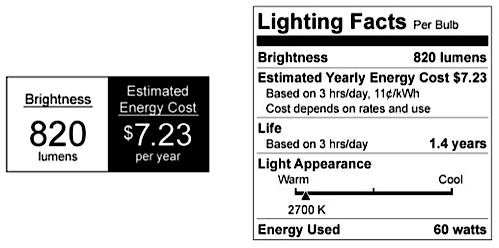As you may have already heard, our light bulbs are changing. They’ll be just as bright but use less energy, cost less, and better protect the environment. Starting in 2012, all screw-based light bulbs sold in the U.S. must meet new federal standards for energy efficiency established by the Energy Independence and Security Act (EISA) of 2007. Under this law, screw-based light bulbs must use fewer watts for a similar light (a.k.a. “lumen”) output. The law’s energy efficiency standards for light bulbs will be phased in over the next three years (see chart below).
We do not strictly control Google ad content. If you believe any Google ad is inappropriate, please email us directly here.
| Today's Bulbs | After the Standard | Standard Effective Date |
| 100 watt | 72 watts or less | January 1, 2012 |
| 75 watt | 53 watts or less | January 1, 2013 |
| 60 watt | 43 watts or less | January 1, 2014 |
| 40 watt | 29 watts or less | January 1, 2014 |
Using light bulbs that provide the same light output but take less energy to run will mean that consumers save money on their utility bills. These savings can make a real difference since lighting accounts for about 12 percent of the average household’s energy bill. Using less energy also helps protect the environment by reducing harmful greenhouse gas emissions.
Another positive change we will see in 2012 is a shift in how we purchase light bulbs. Instead of looking for wattage to determine which bulb to buy, we can now look at the light bulb’s lumens. Lumens tell us how much light a bulb will provide versus Watts, which tell us how much energy the bulb uses.
The Federal Trade Commission has designed a new label that you will see on light bulb packages starting next year. These labels will tell you everything from the brightness of the bulb (lumens), estimated operating costs, how long the bulb should last and what color the light will be. Here’s a sample.

This law will not ban any one lighting technology but will provide buyers will a range of better bulb choices in a variety of colors, bulb types, and light levels, including improved incandescent bulbs, CFLs (Compact Fluorescent Light Bulbs), and LEDs (Light Emitting Diode Light Bulbs). CFLs represent the best value for consumers today. They use about 75 percent less energy than standard incandescent bulbs and last up to 10 times longer. A CFL that has earned the ENERGY STAR can save more than $40 in electricity costs over its lifetime.
About the author:
Brittney Gordon is a member of the ENERGY STAR communication team. She came to EPA one year ago after a career as a broadcast journalist.
Editor’s Note: The opinions expressed in Greenversations are those of the author. They do not reflect EPA policy, endorsement, or action, and EPA does not verify the accuracy or science of the contents of the blog.
HHI Error Correction Policy
HHI is committed to accuracy of content and correcting information that is incomplete or inaccurate. With our broad scope of coverage of healthful indoor environments, and desire to rapidly publish info to benefit the community, mistakes are inevitable. HHI has established an error correction policy to welcome corrections or enhancements to our information. Please help us improve the quality of our content by contacting allen@healthyhouseinstitute.com with corrections or suggestions for improvement. Each contact will receive a respectful reply.
The Healthy House Institute (HHI), a for-profit educational LLC, provides the information on HealthyHouseInstitute.com as a free service to the public. The intent is to disseminate accurate, verified and science-based information on creating healthy home environments.
While an effort is made to ensure the quality of the content and credibility of sources listed on this site, HHI provides no warranty - expressed or implied - and assumes no legal liability for the accuracy, completeness, or usefulness of any information, product or process disclosed on or in conjunction with the site. The views and opinions of the authors or originators expressed herein do not necessarily state or reflect those of HHI: its principals, executives, Board members, advisors or affiliates.
(Note: The views expressed in this blog post are those of the author, and do not necessarily represent those of The Healthy House Institute, LLC.)








